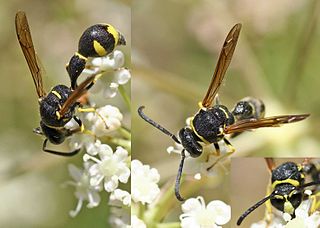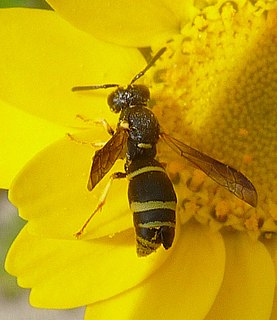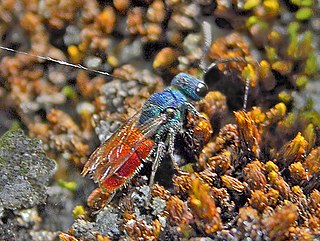| Odynerus | |
|---|---|
 | |
| Odynerus spinipes (Linnaeus) | |
| Scientific classification | |
| Kingdom: | Animalia |
| Phylum: | Euarthropoda |
| Class: | Insecta |
| Order: | Hymenoptera |
| Family: | Vespidae |
| Subfamily: | Eumeninae |
| Genus: | Odynerus Latreille, 1802 |
| Type species | |
| Vespa spinipes Linnaeus, 1758 | |
Odynerus is a primarily Holarctic genus of potter wasps.

The Holarctic is the name for the biogeographic realm that encompasses the majority of habitats found throughout the northern continents of the world, combining Wallace's Palearctic zoogeographical region, consisting of North Africa and all of Eurasia, and the Nearctic zoogeographical region, consisting of North America, north of Mexico. These regions are further subdivided into a variety of ecoregions. Many ecosystems, and the animal and plant communities that depend on them, are found across multiple continents in large portions of this realm. The continuity of these ecosystems results from the shared glacial history of the realm. The floristic Boreal Kingdom corresponds to the Holarctic realm.

Potter wasps, the Eumeninae, are a cosmopolitan wasp group presently treated as a subfamily of Vespidae, but sometimes recognized in the past as a separate family, Eumenidae.
The name of this genus has been widely used as a root to construct many other genus-level names for potter wasps with non-petiolated metasoma, such as Euodynerus , Acarodynerus , Stenodynerus , Parodontodynerus and Incodynerus .

The metasoma is the posterior part of the body, or tagma, of arthropods whose body is composed of three parts, the other two being the prosoma and the mesosoma. In insects, it contains most of the digestive tract, respiratory system, and circulatory system, and the apical segments are typically modified to form genitalia. In a few of the most primitive insects, the metasomal segments bear small, articulated appendages called "styli", which are often considered to be vestigial. There are also pre-apical appendages in most insect orders, called cerci, which may be multi-segmented and almost resembling a posterior pair of antennae; these may be variously modified, or lost entirely. Otherwise, most adult insects lack appendages on the metasoma, though many larval insects have some form of appendages, such as prolegs or, in aquatic insects, gills.

Euodynerus is a genus of potter wasps with a mainly Holarctic distribution, though a number of species extend through Indomalayan, Australasian, Afrotropical and northern Neotropical regions. Also, a single species is reported from Hawaii.
Acarodynerus is an Australasian genus of potter wasps.







